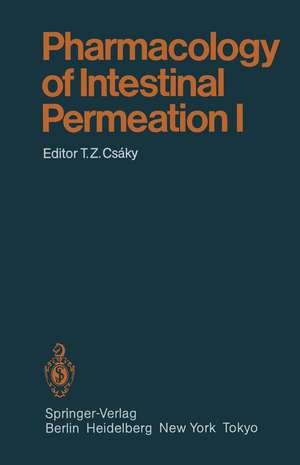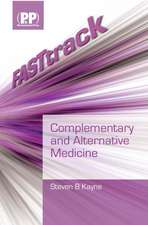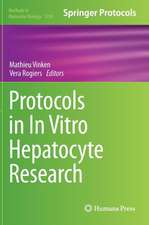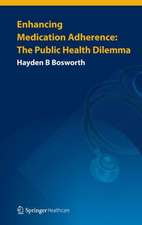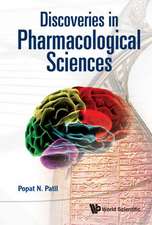Pharmacology of Intestinal Permeation I: Handbook of Experimental Pharmacology, cartea 70 / 1
Contribuţii de W. McD. Armstrongen Limba Engleză Paperback – 4 iun 2012
Din seria Handbook of Experimental Pharmacology
- 5%
 Preț: 3517.78 lei
Preț: 3517.78 lei - 5%
 Preț: 1425.97 lei
Preț: 1425.97 lei - 5%
 Preț: 1435.28 lei
Preț: 1435.28 lei - 5%
 Preț: 1430.52 lei
Preț: 1430.52 lei - 5%
 Preț: 1930.69 lei
Preț: 1930.69 lei - 5%
 Preț: 1922.47 lei
Preț: 1922.47 lei - 5%
 Preț: 1937.46 lei
Preț: 1937.46 lei - 5%
 Preț: 2117.58 lei
Preț: 2117.58 lei - 5%
 Preț: 2119.96 lei
Preț: 2119.96 lei - 5%
 Preț: 2117.38 lei
Preț: 2117.38 lei - 5%
 Preț: 1088.17 lei
Preț: 1088.17 lei - 5%
 Preț: 1098.27 lei
Preț: 1098.27 lei - 5%
 Preț: 1420.29 lei
Preț: 1420.29 lei - 5%
 Preț: 1104.84 lei
Preț: 1104.84 lei - 5%
 Preț: 1104.84 lei
Preț: 1104.84 lei - 5%
 Preț: 1108.14 lei
Preț: 1108.14 lei - 5%
 Preț: 1106.69 lei
Preț: 1106.69 lei - 5%
 Preț: 1105.77 lei
Preț: 1105.77 lei - 5%
 Preț: 1174.35 lei
Preț: 1174.35 lei - 5%
 Preț: 1432.50 lei
Preț: 1432.50 lei - 5%
 Preț: 408.48 lei
Preț: 408.48 lei - 5%
 Preț: 409.63 lei
Preț: 409.63 lei - 5%
 Preț: 539.90 lei
Preț: 539.90 lei - 5%
 Preț: 720.47 lei
Preț: 720.47 lei - 5%
 Preț: 733.09 lei
Preț: 733.09 lei - 5%
 Preț: 731.27 lei
Preț: 731.27 lei - 5%
 Preț: 746.43 lei
Preț: 746.43 lei - 5%
 Preț: 747.72 lei
Preț: 747.72 lei - 5%
 Preț: 725.24 lei
Preț: 725.24 lei - 5%
 Preț: 742.80 lei
Preț: 742.80 lei - 5%
 Preț: 393.23 lei
Preț: 393.23 lei - 5%
 Preț: 735.66 lei
Preț: 735.66 lei - 5%
 Preț: 728.33 lei
Preț: 728.33 lei - 5%
 Preț: 389.52 lei
Preț: 389.52 lei - 5%
 Preț: 730.71 lei
Preț: 730.71 lei - 5%
 Preț: 740.58 lei
Preț: 740.58 lei - 5%
 Preț: 730.19 lei
Preț: 730.19 lei - 5%
 Preț: 723.42 lei
Preț: 723.42 lei - 5%
 Preț: 731.27 lei
Preț: 731.27 lei - 5%
 Preț: 726.68 lei
Preț: 726.68 lei - 5%
 Preț: 3516.49 lei
Preț: 3516.49 lei - 5%
 Preț: 729.26 lei
Preț: 729.26 lei - 5%
 Preț: 737.11 lei
Preț: 737.11 lei - 5%
 Preț: 730.92 lei
Preț: 730.92 lei - 5%
 Preț: 738.78 lei
Preț: 738.78 lei - 5%
 Preț: 909.94 lei
Preț: 909.94 lei - 5%
 Preț: 720.10 lei
Preț: 720.10 lei - 5%
 Preț: 734.74 lei
Preț: 734.74 lei - 5%
 Preț: 727.80 lei
Preț: 727.80 lei
Preț: 1123.87 lei
Preț vechi: 1183.01 lei
-5% Nou
Puncte Express: 1686
Preț estimativ în valută:
215.06€ • 226.14$ • 177.70£
215.06€ • 226.14$ • 177.70£
Carte tipărită la comandă
Livrare economică 17 aprilie-01 mai
Preluare comenzi: 021 569.72.76
Specificații
ISBN-13: 9783642695070
ISBN-10: 3642695078
Pagini: 708
Ilustrații: XX, 708 p.
Dimensiuni: 170 x 242 x 43 mm
Greutate: 1.15 kg
Ediția:Softcover reprint of the original 1st ed. 1984
Editura: Springer Berlin, Heidelberg
Colecția Springer
Seria Handbook of Experimental Pharmacology
Locul publicării:Berlin, Heidelberg, Germany
ISBN-10: 3642695078
Pagini: 708
Ilustrații: XX, 708 p.
Dimensiuni: 170 x 242 x 43 mm
Greutate: 1.15 kg
Ediția:Softcover reprint of the original 1st ed. 1984
Editura: Springer Berlin, Heidelberg
Colecția Springer
Seria Handbook of Experimental Pharmacology
Locul publicării:Berlin, Heidelberg, Germany
Public țintă
ResearchCuprins
1 Morphology of the Intestinal Mucosa..- 2 Intestinal Permeation and Permeability: an Overview..- 3 Permeability and Related Phenomena: Basic Concepts.- 4 Methods for Investigation of Intestinal Permeability.- 5 Vascular Perfusion of Rat Small Intestine for Permeation and Metabolism Studies.- 6 The Use of Isolated Membrane Vesicles in the Study of Intestinal Permeation.- 7 The Transport Carrier Principle.- 8 Energetics of Intestinal Absorption.- 9 Polarity of Intestinal Epithelial Cells: Permeability of the Brush Border and Basolateral Membranes.- 10 Electrical Phenomena and Ion Transport in the Small Intestine.- 11 Intestinal Permeation of Water.- 12 Intestinal Permeability to Calcium and Phosphate.- 13 Protein-Mediated Epithelial Iron Transfer.- 14 Intestinal Absorption of Heavy Metals.- 15 Intestinal Permeability of Water-Soluble Nonelectrolytes: Sugars, Amino Acids, Peptides.- 16 Pharmacologic Aspects of Intestinal Permeability to Lipids (Except Steroids and Fat-Soluble Vitamins).- 17 Intestinal Absorption of the Fat-Soluble Vitamins: Physiology and Pharmacology.
